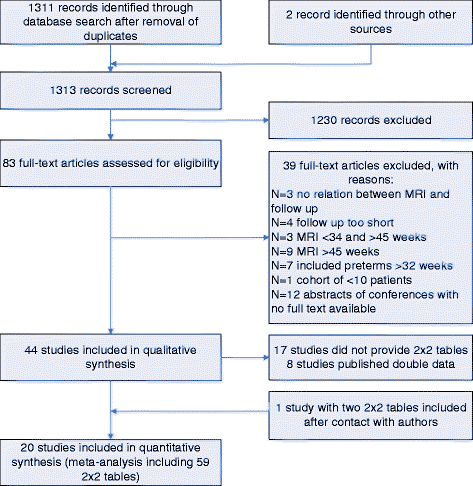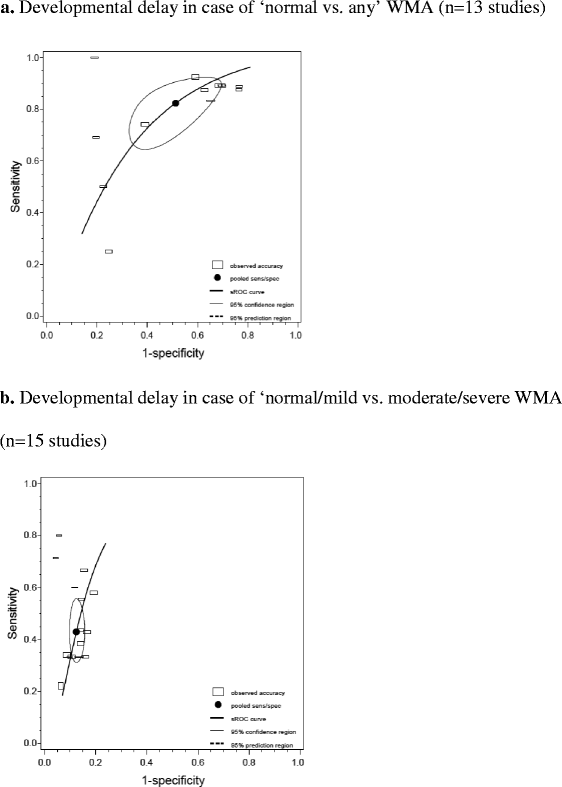Predicting developmental outcomes in premature infants by term equivalent MRI: systematic review and meta-analysis
- PMID: 25982565
- PMCID: PMC4438620
- DOI: 10.1186/s13643-015-0058-7
Predicting developmental outcomes in premature infants by term equivalent MRI: systematic review and meta-analysis
Abstract
Background: This study aims to determine the prognostic accuracy of term MRI in very preterm born (≤32 weeks) or low-birth-weight (≤1500 g) infants for long-term (>18 months) developmental outcomes.
Methods: We performed a systematic review searching Central, Medline, Embase, and PsycInfo. Two independent reviewers performed study selection, data extraction, and quality assessment. We documented sensitivity and specificity for three different MRI findings (white matter abnormalities (WMA), brain abnormality (BA), and diffuse excessive high signal intensity (DEHSI)), related to developmental outcomes including cerebral palsy (CP), visual and/or hearing problems, motor, neurocognitive, and behavioral function. Using bivariate meta-analysis, we estimated pooled sensitivity and specificity and plotted summary receiver operating characteristic (sROC) curves for different cut-offs of MRI.
Results: We included 20 papers published between 2000 and 2013. Quality of included studies varied. Pooled sensitivity and specificity values (95 % confidence interval (CI)) for prediction of CP combining the three different MRI findings (using normal/mild vs. moderate/severe cut-off) were 77 % (53 to 91 %) and 79 % (51 to 93 %), respectively. For prediction of motor function, the values were 72 % (52 to 86 %) and 62 % (29 to 87 %), respectively. Prognostic accuracy for visual and/or hearing problems, neurocognitive, and/or behavioral function was poor. sROC curves of the individual MRI findings showed that presence of WMA provided the best prognostic accuracy whereas DEHSI did not show any potential prognostic accuracy.
Conclusions: This study shows that presence of moderate/severe WMA on MRI around term equivalent age can predict CP and motor function in very preterm or low-birth-weight infants with moderate sensitivity and specificity. Its ability to predict other long-term outcomes such as neurocognitive and behavioral impairments is limited. Also, other white matter related tests as BA and DEHSI demonstrated limited prognostic value.
Systematic review registration: PROSPERO CRD42013006362.
Figures




References
-
- Ment LR, Bada HS, Barnes P, Grant PE, Hirtz D, Papile LA, et al. Practice parameter: neuroimaging of the neonate: report of the quality standards subcommittee of the American Academy of Neurology and the Practice Committee of the Child Neurology Society. Neurology. 2002;58:1726–38. doi: 10.1212/WNL.58.12.1726. - DOI - PubMed
Publication types
MeSH terms
LinkOut - more resources
Full Text Sources
Other Literature Sources
Medical
Miscellaneous

